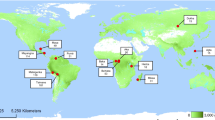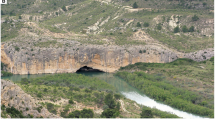Abstract
A long-standing hypothesis suggests that the transition from hunting and gathering to agriculture results in people working harder, spending more time engaged in subsistence activities and having less leisure time1,2. However, tests of this hypothesis are obscured by comparing between populations that vary in ecology and social organization, as well as subsistence3,4,5,6. Here we test this hypothesis by examining adult time allocation among the Agta—a population of small-scale hunter-gatherers from the northern Philippines who are increasingly engaged in agriculture and other non-foraging work. We find that individuals in camps engaging more in non-foraging work spend more time involved in out-of-camp work and have substantially less leisure time. This difference is largely driven by changes in the time allocation of women, who spend substantially more time engaged in out-of-camp work in more agricultural camps. Our results support the hypothesis that hunting and gathering allows a significant amount of leisure time, and that this is lost as communities adopt small-scale agriculture.
This is a preview of subscription content, access via your institution
Access options
Access Nature and 54 other Nature Portfolio journals
Get Nature+, our best-value online-access subscription
$29.99 / 30 days
cancel any time
Subscribe to this journal
Receive 12 digital issues and online access to articles
$119.00 per year
only $9.92 per issue
Buy this article
- Purchase on Springer Link
- Instant access to full article PDF
Prices may be subject to local taxes which are calculated during checkout


Similar content being viewed by others
Data availability
The individual-level data that support the findings of this study are available from the corresponding author upon reasonable request. Any further work on the data depends on community approval.
Code availability
The code used to analyse the relevant data is provided as Supplementary Software.
References
Sahlins, M. Stone Age Economics (Aldine, 1973).
Bowles, S. Cultivation of cereals by the first farmers was not more productive than foraging. Proc. Natl Acad. Sci. USA 108, 4760–4765 (2011).
Hill, K., Kaplan, H., Hawkes, K. & Hurtado, A. M. Men’s time allocation to subsistence work among the Ache of Eastern Paraguay. Hum. Ecol. 13, 29–47 (1985).
Lee, R. B. The !Kung San (Cambridge Univ. Press, 1979).
Hames, R. Time, efficiency, and fitness in the Amazonian protein quest. Res. Econ. Anthropol. 11, 43–85 (1989).
Kelly, R. The Lifeways of Hunter-gatherers: The Foraging Spectrum (Cambridge Univ. Press, 2013).
Barker, G. The Agricultural Revolution in Prehistory: Why did Foragers Become Farmers? (Oxford Univ. Press, 2006).
Diamond, J. & Bellwood, P. Farmers and their languages: the first expansions. Science 300, 597–603 (2003).
Page, A. E. et al. Reproductive trade-offs in extant hunter-gatherers suggest adaptive mechanism for the Neolithic expansion. Proc. Natl Acad. Sci. USA 113, 4694–4699 (2016).
Bentley, G. R., Jasienska, G. & Goldberg, T. Is the fertility of agriculturalists higher than that of nonagriculturalists? Curr. Anthropol. 34, 778–785 (1993).
Starling, A. P. & Stock, J. T. Dental indicators of health and stress in early Egyptian and Nubian agriculturalists: a difficult transition and gradual recovery. Am. J. Phys. Anthropol. 134, 520–528 (2007).
Armelagos, G. J. & Cohen, M. N. Paleopathology at the Origins of Agriculture (Academic Press, 1984).
Gallagher, E. M., Shennan, S. J. & Thomas, M. G. Transition to farming more likely for small, conservative groups with property rights, but increased productivity is not essential. Proc. Natl Acad. Sci. USA 112, 14218–14223 (2015).
Bowles, S. & Choi, J.-K. Coevolution of farming and private property during the early Holocene. Proc. Natl Acad. Sci. USA 110, 8830–8835 (2013).
Hawkes, K., Kaplan, H., Hill, K. & Hurtado, A. M. Ache at the settlement: contrasts between farming and foraging. Hum. Ecol. 15, 133–161 (1987).
Hawkes, K. & O’Connell, J. F. Affluent hunters? Some comments in light of the Alyawara case. Am. Anthropol. 83, 622–626 (1981).
Rai, N. K. Living in a Lean-to: Philippine Negrito Foragers in Transition (Univ. Michigan Press, 1990).
Minter, T. The Agta of the Northern Sierra Madre (Lieden Univ., 2008).
Griffin, P. & Estioko-Griffin, A. The Agta of Northeastern Luzon: Recent Studies (Univ. San Carlos Publications, 1985).
Dyble, M. et al. Networks of food sharing reveal the functional significance of multilevel sociality in two hunter-gatherer groups. Curr. Biol. 26, 2017–2021 (2016).
Dyble, M. et al. Sex equality can explain the unique social structure of hunter-gatherer bands. Science 348, 796–798 (2015).
Bürkner, P.-C. Advanced Bayesian multilevel modeling with the R package brms. R. J. 10, 395–411 (2018).
Koster, J. & McElreath, R. Multinomial analysis of behavior: statistical methods. Behav. Ecol. Sociobiol. 71, 138 (2017).
Bird-David, N. Beyond “the original affluent society” a culturalist reformulation. Curr. Anthropol. 33, 25–47 (1992).
Page, A. E., Minter, T., Viguier, S. & Migliano, A. B. Hunter-gatherer health and development policy: how the promotion of sedentism worsens the Agta’s health outcomes. Soc. Sci. Med. 197, 39–48 (2018).
Marlowe, F. W. A critical period for provisioning by Hadza men. Evol. Hum. Behav. 24, 217–229 (2003).
McElreath, R. & Koster, J. Using multilevel models to estimate variation in foraging returns. Effects of failure rate, harvest size, age, and individual heterogeneity. Hum. Nat. 25, 100–120 (2014).
Dunbar, R. I. M., Korstjens, A. H. & Lehmann, J. Time as an ecological constraint. Biol. Rev. Camb. Phil. Soc. 84, 413–429 (2009).
Hart, J. A. From subsistence to market: a case study of the Mbuti net hunters. Hum. Ecol. 6, 325–353 (1978).
Headland, T. N. The wild yam question: how well could independent hunter-gatherers live in a tropical rain forest ecosystem? Hum. Ecol. 15, 463–491 (1987).
Kaplan, H. et al. A theory of human life history evolution: diet, intelligence, and longevity. Evol. Anthropol. 9, 156–185 (2000).
Boyd, R., Richerson, P. J. & Henrich, J. The cultural niche: why social learning is essential for human adaptation. Proc. Natl Acad. Sci. USA 108, 10918–10925 (2011).
Apicella, C. L., Marlowe, F. W., Fowler, J. H. & Christakis, N. A. Social networks and cooperation in hunter-gatherers. Nature 481, 497–501 (2012).
Smith, D. et al. A friend in need is a friend indeed: need-based sharing, rather than cooperative assortment, predicts experimental resource transfers among Agta hunter-gatherers. Evol. Hum. Behav. 40, 82–89 (2019).
Dyble, M., Gardner, A., Vinicius, L. & Migliano, A. B. Inclusive fitness for in-laws. Biol. Lett. 14, 20180515 (2018).
Diekmann, Y. et al. Accurate age estimation in small-scale societies. Proc. Natl Acad. Sci. USA 114, 8205–8210 (2017).
Acknowledgements
We thank R. K. Schlaepfer, K. Major, S. Viguier and the Curampez family for assistance in the field, C. Duncan and D. Rubenstein for comments on the manuscript, and the Agta and Paranan communities for their hospitality. This project was funded by Leverhulme Trust grant RP2011-R-045 to A.B.M. The funders had no role in study design, data collection and analysis, decision to publish or preparation of the manuscript.
Author information
Authors and Affiliations
Contributions
M.D. conceived of the study and wrote the manuscript. M.D. and J.T. analysed the data. M.D., A.E.P., D.S. and A.B.M. collected the data. All authors discussed the results and contributed towards improving the final manuscript.
Corresponding author
Ethics declarations
Competing interests
The authors declare no competing interests.
Additional information
Publisher’s note: Springer Nature remains neutral with regard to jurisdictional claims in published maps and institutional affiliations.
Supplementary information
Supplementary Information
Supplementary Figs. 1–6 and Supplementary Tables 1–4.
Supplementary Software
R code used to analyse Agta time budget data.
Rights and permissions
About this article
Cite this article
Dyble, M., Thorley, J., Page, A.E. et al. Engagement in agricultural work is associated with reduced leisure time among Agta hunter-gatherers. Nat Hum Behav 3, 792–796 (2019). https://doi.org/10.1038/s41562-019-0614-6
Received:
Accepted:
Published:
Issue Date:
DOI: https://doi.org/10.1038/s41562-019-0614-6
This article is cited by
-
Considering Ideas of Collective Action, Institutions, and “Hunter-Gatherers” in the American Southeast
Journal of Archaeological Research (2023)
-
The worst mistake 2.0? The digital revolution and the consequences of innovation
AI & SOCIETY (2022)
-
Socioecology shapes child and adolescent time allocation in twelve hunter-gatherer and mixed-subsistence forager societies
Scientific Reports (2022)
-
Global hunter-gatherer population densities constrained by influence of seasonality on diet composition
Nature Ecology & Evolution (2021)
-
Did foragers enjoy more free time?
Nature Human Behaviour (2019)



